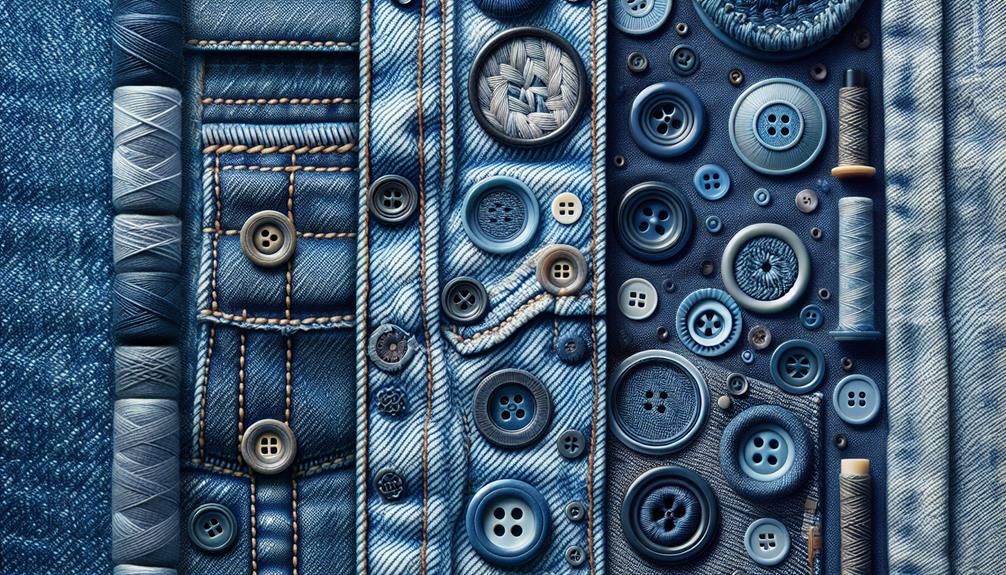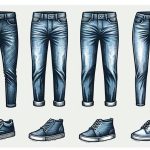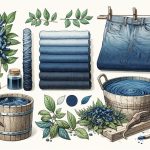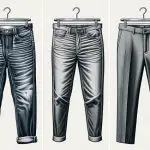Ever noticed folks mixing up denim and jeans as if they're the same? Here's the lowdown: denim's the tough fabric we all love, dyed with that signature indigo giving it a unique look over time. Jeans, on the other hand, are the actual pants crafted from denim, evolving from rugged workwear to a fashion must-have. But here's the kicker, understanding the journey from denim to jeans opens up a whole world of style and history. Why stop here when there's a treasure trove of insights on how this iconic fabric shapes our closets and culture?
Table of Contents
Key Takeaways
- Denim is a sturdy cotton twill fabric, while jeans are a type of clothing made from denim.
- Denim refers to the material itself, used in various items like jackets and skirts, not just jeans.
- Jeans are characterized by specific styles such as skinny, bootcut, or boyfriend, which are all made using denim fabric.
- The term "denim" comes from the fabric's history and composition, whereas "jeans" refers to the actual garment design and function.
- Care and maintenance practices apply to denim as a material, influencing the longevity and appearance of jeans as a product.
Understanding Denim Fabric
Delving into denim, it's a tough cotton twill fabric that's become a staple in wardrobes around the globe, known for its durability and unique fading charm. At its core, denim's a 100% cotton fabric, celebrated for its strength that comes from the twill weave. This isn't just any cotton fabric; it's one that's been through the wringer, dyed with indigo to give it that classic blue that fades so distinctively over time. The warp threads, those dyed with indigo, are what give denim its character, developing those fading characteristics we all love.
What's really cool is most of the indigo used today is synthetic, which means we get that consistent color and fade, making each piece uniquely ours. But it's not just about the dye. Denim's customization potential is off the charts. With treatments like washing, stone-washing, or an enzyme wash, you can really make a piece your own. It's these treatments and the fabric's unique characteristics that turn simple denim into something that can express individual style.
The Evolution of Jeans
Jeans, originally designed for the gritty work of miners and cowboys, have evolved into a global fashion icon. Let me break it down for you.
Back in the 19th century, denim was the go-to fabric for making these durable pants. Then came Levi Strauss in 1873, who literally changed the game by filing a patent for jeans. This move wasn't just a win for durable workwear; it set the stage for denim's massive evolution.
By the 1950s, jeans had taken on a whole new role. They weren't just for hard labor anymore. They became a symbol of rebellion, a badge of honor in youth culture. We're talking about the kind of shift that takes something from practical to iconic.
Fast forward to the mid-20th century, and jeans had completed their transformation. They went from being essential workwear to a fashion staple. And let's talk diversity – styles like skinny, bootcut, and boyfriend fits popped up, catering to everyone's taste.
Care and Maintenance Tips
To keep your denim looking its best, there are a few key care and maintenance tips you'll want to follow. Understanding the difference between denim as a fabric—a durable cotton twill that's dyed and designed to wear and fade over time—and how you treat it can significantly impact its durability and appearance.
Here's what I've found works best to maintain my denim:
- Wash Sparingly: Too much washing can strip denim of its color and character. When you do wash, turn the denim inside out to protect the dyed surface. This minimizes friction and helps maintain the outer appearance.
- Cold Water and Mild Detergent: Always opt for cold water and a mild detergent. Hot water and harsh detergents can damage the cotton fibers, causing excessive shrinking and fading. This care tip ensures the fabric maintains its integrity for longer.
- Dry Wisely: Skip the dryer. Hang drying is the way to go to preserve the shape and color of your denim. It prevents unnecessary stress and damage to the fabric.
Storing your denim in a cool, dry place away from direct sunlight also plays a critical role in maintaining its color and preventing discoloration. Following these maintenance tips can make a huge difference in extending the life and look of your denim.
Varieties and Styles
After brushing up on how to care for denim, let's explore the wide variety of styles and models jeans have to offer. From the cornerstone of American culture to a staple in fashion worldwide, jeans have evolved beyond simple cotton twill trousers into a plethora of types, each with its own identity.
| Type | Description |
|---|---|
| Skinny | Tight-fitting from waist to ankles, emphasizing a slim figure. |
| Straight | Classic cut with a straight leg, versatile for any occasion. |
| Bootcut | Slightly flared from the knee to accommodate boots. |
| Boyfriend | Loosely fitted for a relaxed and comfy vibe. |
Each style caters to different body types and fashion preferences, making jeans an indispensable part of our wardrobes. The denim's raw material allows for a variety of accessories and finishes, from the rugged look of distressed details like fading and whiskering to the clean and polished appearance of dark wash jeans. With each pair, whether it's embracing the slim fit trend or opting for the comfort of a wide-leg, jeans offer a way to express our individuality while remaining firmly rooted in the fabric of United States culture.
Sustainability and Fashion Trends
Increasingly, fashion brands are stepping up to integrate sustainable practices in denim production, focusing on reducing environmental impacts. It's not just about making jeans look good anymore; it's about doing good, too.
Here's the lowdown on how the denim game is changing for the better:
- Reducing Water Usage and Chemical Waste: We're seeing a major shift towards methods that cut down on the gallons of water and nasty chemicals traditionally needed to make our jeans. By innovating in this area, brands are significantly lowering the environmental footprint of every pair.
- Eco-Friendly Materials: More and more, recycled denim and organic cotton are becoming the go-to materials. This switch not only reduces waste but also minimizes the harmful effects of pesticide use in cotton farming, making each pair a bit greener.
- Circular Fashion and Ethical Production: The coolest trend? Circular fashion models that emphasize recycling and upcycling, alongside a push for ethically produced denim. This approach not only tackles waste but also ensures fair conditions for workers.
As someone who loves fashion but worries about our planet, it's heartening to see sustainable fashion choices becoming mainstream. Sustainable denim production isn't just a trend; it's the future, and it's about time we all got on board.
Frequently Asked Questions
Are Jeans and Denim the Same Thing?
I've often wondered if jeans and denim are the same. Turns out, they're not. Denim's the fabric, and it's used to make jeans, among other items. So, jeans are a product made from denim.
Why Is It Called Jeans Not Denim?
It's called jeans, not denim, because "jeans" refers to the style of pants made from denim fabric. Levi Strauss popularized the term, highlighting the durable and practical nature of these iconic trousers.
What Is the Difference Between Denim and Non Denim Jeans?
I've learned that the key difference lies in the material. Denim jeans are made from cotton twill, while non-denim ones come in various fabrics like corduroy. This affects their texture, color, and comfort.
What's Considered Denim?
I've learned that denim's a durable cotton twill fabric, often dyed with indigo, and used in various clothes. It's all about the material's tight weave and strength, setting the stage for some quality apparel.
- The Use of Nonwovens in Construction and Civil Engineering - July 11, 2025
- The Use of Nonwovens in Construction and Civil Engineering - July 11, 2025
- The Use of Nonwovens in Construction and Civil Engineering - July 11, 2025







